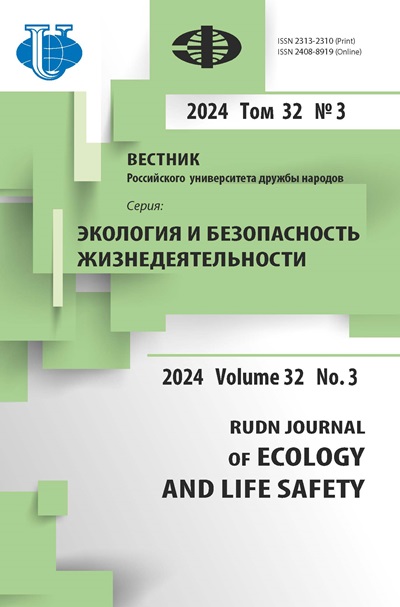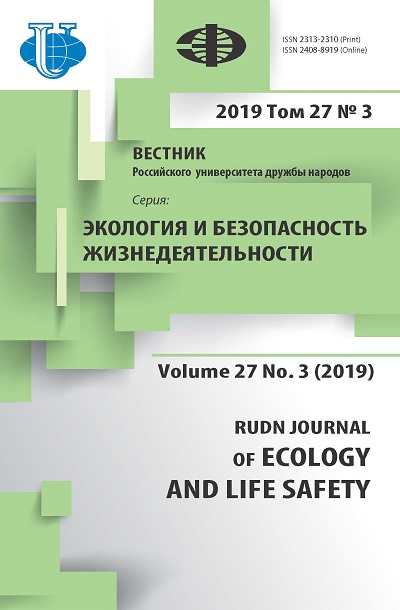Том 27, № 3 (2019)
- Год: 2019
- Статей: 8
- URL: https://journals.rudn.ru/ecology/issue/view/1334
- DOI: https://doi.org/10.22363/2313-2310-2019-27-3
Весь выпуск
Промышленная экология
Комплексная оценка воздействия на окружающую среду при эксплуатации опытно-промышленной установки по переработке лежалых хвостов Хинганского месторождения олова
Аннотация
В статье представлены результаты комплексной оценки воздействия на окружающую среду при извлечении олова из лежалых хвостов, накопленных в хвостохранилищах в период эксплуатации Хинганского месторождения. Хвостохранилища представляют угрозу для окружающей среды и одновременно являются источником техногенного сырья. Эксплуатация опытно-промышленной установки гравитационно-флотационного типа окажет на окружающую среду несущественное воздействие, на социально-экономическую сферу - низкое положительное. При этом существенно улучшится экологическая ситуация в связи с ликвидацией хвостохранилищ.
 163-172
163-172


Объединенная судовая система приготовления и кондиционирования питьевой воды
Аннотация
В статье рассмотрены способы сохранения качества питьевой воды при длительном хранении в закрытых судовых емкостях. Проанализированы методы очистки воды применительно к судовым условиям, которые позволили выбрать наиболее перспективные и безопасные. Дана классификация активированных окислительных технологий. Предложена функциональная схема объединенной судовой системы приготовления и кондиционирования питьевой воды.
 173-183
173-183


Дальность распространения полициклических ароматических углеводородов в тундровой зоне под воздействием ТЭС
Аннотация
Pleurozium schreberi Brid. широко распространен в тундровой зоне и чувствителен к изменениям в составе полициклических ароматических углеводородов (ПАУ) в экосистемах во временном отношении и с расстоянием, поэтому может использоваться в качестве индикатора загрязнения тундровых биоценозов полиаренами. Целью исследования было оценить дальность распространения ПАУ в условиях тундровой зоны на примере воздействия теплоэлектростанции. Работы проводились в Большеземельской тундре в Воркутинском районе Республики Коми. Исследовано поверхностное накопление и общее содержание ПАУ в Pleurozium schreberi и органогенном горизонте тундровых поверхностно-глеевых почв (Stagnic Cambisols) на фоновом участке и удалении от ТЭС 0,5; 1; 1,5; 3; 5 и 12 км. Содержание ПАУ в Pleurozium schreberi под воздействием ТЭС с расстоянием изменялось нелинейно. Максимум накопления отмечен на расстоянии в 3 км, затем содержание ПАУ снижалось и достигало фонового уровня в 12 км от источника. Высокомолекулярные ПАУ перемещались на расстояние до 3 км, где выпадали на поверхность мхов, легкие распространялись дальше, что обусловлено концентрированием тяжелых и легких структур на частицах разного диаметра. На поверхности мха фонового и загрязненного участка не выявлено присутствие нафталина. Суммарное содержание полиаренов на поверхности мхов примерно одинаково. На участке в 3 км отмечено резкое повышение массовой доли поверхностных ПАУ в 3 раза за счет возрастания массовой доли 4-5-ядерных полиаренов. В условиях загрязнения активизировались процессы биоаккумуляции ПАУ, полиарены с поверхности мха активно транспортировались внутрь. Исключением являлся участок в 3 км от ТЭС, где доля поверхностного накопления возрастала при максимальном загрязнении, то есть поступление ПАУ внутрь мха снижалось. Установлено, что для правильной идентификации пиков поступления полиаренов необходимо использовать отмершую часть Pleurozium schreberi или мох в целом. Изменения в содержании полиаренов в органогенных горизонтах почв идентичны с Pleurozium schreberi. Показано, что ПАУ в условиях тундры способны перемещаться на значительные расстояния. Приближенные к фоновым значения содержания ПАУ в Pleurozium schreberi выявлены лишь на расстоянии в 12 км от ТЭС, для органогенных горизонтов почв значения близкие к фоновым не выявлены.
 184-198
184-198


Безопасность жизнедеятельности
Негативные факторы воздушной среды на производствах легкой промышленности и их воздействие на работающих
Аннотация
Создание благоприятных условий труда является одной из важнейших задач современного производства. Наблюдаемый в последние годы рост изготовления продукции легкой промышленности, сопровождающийся негативным воздействием на воздушную среду производственных помещений, подтверждает необходимость и актуальность исследований в данной области. Цель настоящей работы состоит в определении особенностей формирования воздушной среды внутри цехов и ее воздействия на работающих с учетом специфики производств легкой промышленности. Изучение температурно-влажностного состояния воздуха проводилось методом натурных приборно-инструментальных замеров внутри помещений. Особенность исследования состоит в том, что измерения выполнялись на значительном количестве современных действующих предприятий при аттестации рабочих мест с привлечением лабораторий, аккредитованных органами Государственного санитарно-эпидемиологического надзора. Результатом исследования стало определение рабочих мест и зон, не отвечающих нормативным требованиям. В заключение даны общие рекомендации по снижению негативных факторов воздушной среды и их воздействия на работающих.
 199-208
199-208


Защита окружающей среды
Оценка экологической комфортности почв городских экосистем при воздействии на них тяжелых металлов
Аннотация
Оценка экологического состояния компонентов окружающей среды на территориях городов играет важную роль в достижении экологической безопасности и экологической комфортности для проживания человека, а также ведения хозяйственной деятельности. В работе представлен и апробирован комплексный индекс экологической комфортности почв, потенциально и актуально подверженных воздействию тяжелых металлов, рассчитываемый по отношению суммарного воздействия тяжелых металлов (ТМ) на почвы, растения и почвенную биоту к сумме показателей экологической устойчивости почв к данному воздействию и способности почв препятствовать загрязнению ТМ сопредельных территорий. Предложена шкала нормирования экологической комфортности почв на примере городских экосистем Курска. Отмечено, что на территории города 42,8 % почв исследуемых ключевых участков, расположенных в санитарно-защитных и рекреационных зонах, являются экологически комфортными, в то время как 57,2 % почв промышленных, селитебных и санитарно-защитных функциональных зон города находятся за пределами экологической комфортности.
 209-218
209-218


Оценка рисков возникновения и последствий разливов нефти в районе Чебоксарского речного порта
Аннотация
В связи со значительным количеством инцидентов разливов нефти для разработки планов по их предупреждению и ликвидации последствий важную роль играет прогнозирование разливов. В данной статье авторами предлагается анализ риска загрязнения нефтью с судов в районе Чебоксарского речного порта, выполненный через определение частоты возникновения разливов нефти в районе указанного порта, оценку последствий (убытков) и обобщение полученных оценок. При этом с помощью математического моделирования разливов нефти в районе Чебоксарского речного порта были разработаны регрессионные модели оценки ущербообразующих факторов и рассчитан размер вреда компонентам природной среды (воде, почве, воздуху). Результаты выполненных исследований могут быть использованы при разработке мероприятий по предотвращению или снижению неблагоприятных последствий от чрезвычайных ситуаций с учетом природно-климатических условий.
 219-230
219-230


Управление природными ресурсами
Обзор юго-восточной части Нигерии: экологические проблемы и управленческие решения
Аннотация
 231-240
231-240


Краткие сообщения
Индекс орнитологической привлекательности объектов по переработке и размещению твердых коммунальных отходов
Аннотация
В связи с увеличением числа хозяйственных объектов, привлекающих птиц, и повсеместным ростом популяций синантропных птиц проблема орнитологической безопасности становится все более актуальной. Для эффективного отпугивания птиц с территорий, где их присутствие нежелательно, необходимо понимать, что этих птиц привело на данную территорию, то есть важно выяснить причины орнитологической привлекательности хозяйственного объекта. В статье описывается метод, позволяющий рассчитать орнитологическую привлекательность любого хозяйственного объекта. На основании этих расчетов можно планировать место, время и режим работы специалистов по отпугиванию птиц.
 241-246
241-246
















